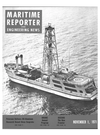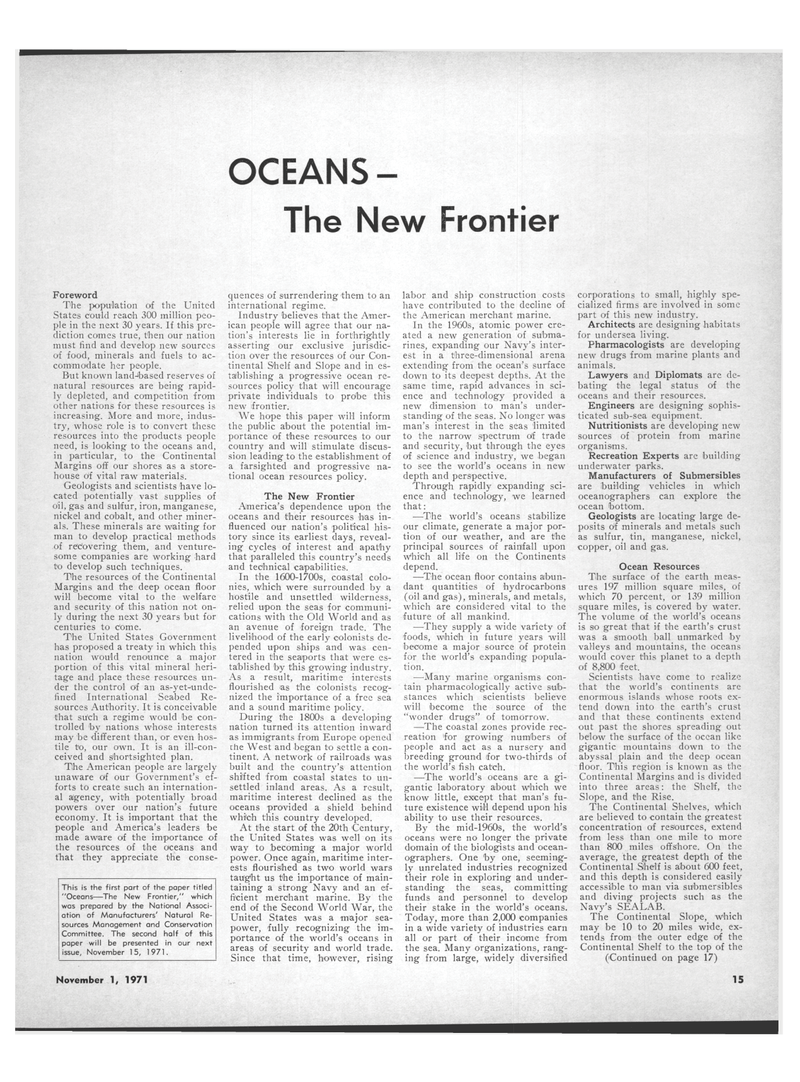
Page 13: of Maritime Reporter Magazine (November 1971)
Read this page in Pdf, Flash or Html5 edition of November 1971 Maritime Reporter Magazine
OCEANS -
The New Frontier
Foreword
The population of the United
States could reach 300 million peo- ple in the next 30 years. If this pre- diction comes true, then our nation must find and develop new sources of food, minerals and fuels to ac- commodate her people.
But known land-based reserves of natural resources are being rapid- ly depleted, and competition from other nations for these resources is increasing. More and more, indus- try, whose role is to convert these resources into the products people need, is looking to the oceans and, in particular, to the Continental
Margins off our shores as a store- house Of vital raw materials.
Geologists and scientists have lo- cated potentially vast supplies of oil, gas and sulfur, iron, manganese, nickel and cobalt, and other miner- als. These minerals are waiting for man to develop practical methods of recovering them, and venture- some companies are working hard to develop such techniques.
The resources of the Continental
Margins and the deep ocean floor will become vital to the welfare and security of this nation not on- ly during the next 30 years but for centuries to Come.
The United States Government has proposed a treaty in which this nation would renounce a major portion of this vital mineral heri- tage and place these resources un- der the control of an as-yet-unde- fined International Seabed Re- sources Authority. It is conceivable that su'ch a regime would be con- trolled 'by nations whose interests may be different than, or even hos- tile to, our own. It is an ill-con- ceived and shortsighted plan.
The American people are largely unaware of our Government's ef- forts to create such an internation- al agency, with potentially broad powers over our nation's future economy. It is important that the people and America's leaders be made aware of the importance of the resources of the oceans and that they appreciate the conse-
Th is is the first part of the paper titled "Oceans—The New Frontier," which was prepared by the National Associ- ation of Manufacturers' Natural Re- sources Management and Conservation
Committee. The second half of this paper will be presented in our next issue, November 15, 1971. quences of surrendering them to an international regime.
Industry believes that the Amer- ican people will agree that our na- tion's interests lie in forthrightly asserting our exclusive jurisdic- tion over the resources of our Con- tinental Shelf and Slope and in es- tablishing a progressive ocean re- sources policy that will encourage private individuals to prObe this new (frontier.
We hope this paper will inform the public about the potential im- portance of these resources to our country and will stimulate discus- sion leading to the establishment of a farsighted and progressive na- tional ocean resources policy.
The New Frontier
America's dependence upon the oceans and their resources has in- fluenced our nation's political his- tory since its earliest days, reveal- ing cycles of interest and apathy that paralleled this country's needs and technical capabilities.
In the 1600-1700s, coastal colo- nies, which were surrounded by a hostile and unsettled wilderness, relied upon the seas for communi- cations with the Old World and as an avenue of foreign trade. The livelihood of the early colonists de- pended upon ships and was cen- tered in the seaports that were es- tablished by this growing industry.
As a result, maritime interests flourished as the colonists recog- nized the importance of a free sea and a sound maritime policy.
During the 1800s a developing nation turned its attention inward as immigrants from Europe opened che West and began to settle a con- tinent. A network of railroads was built and the country's attention shifted from coastal states to un- settled inland areas. As a result, maritime interest declined as the oceans provided a shield behind which this country developed.
At the start of the 20th Century, the United States was well on its way to becoming a major world power. Once again, maritime inter- ests flourished as two world wars taught us the importance of main- taining a strong Navy and an ef- ficient merchant marine. By the end of the Second World War, the
United States was a major sea- power, fully recognizing the irn^ portan'ce of the world's oceans in areas of security and world trade.
Since that time, however, rising labor and ship construction costs have contributed to the decline of the American merchant marine.
In the 1960s, atomic power cre- ated a new generation of subma- rines, expanding our Navy's inter- est in a three-dimensional arena extending from the ocean's surface down to its deepest depths. At the same time, rapid advances in sci- ence and technology provided a new dimension to man's under- standing of the seas. No longer was man's interest in the seas limited to the narrow sipectrum Of trade and security, but through the eyes of science and industry, we began to see the world's oceans in new depth and perspective.
Through rapidly expanding sci- ence and technology, we learned that: —The world's oceans stabilize our climate, generate a major por- tion of our weather, and are the principal sources of rainfall upon which all life on the Continents depend. —The ocean floor contains abun- dant quantities of hydrocarbons (oil and gas), minerals, and metals, which are considered vital to the future of all mankind. —They supply a wide variety of foods, which in future years will become a major source of protein for the world's expanding popula- tion. —Many marine organisms con- tain pharmacologically active sub- stances which scientists believe will become the source of the "wonder drugs" of tomorrow. —-The coastal zones provide rec- reation 'for growing numbers of people and act as a nursery and breeding ground ifor two-thirds of the world's fish catch. —The world's oceans are a gi- gantic laboratory about which we know little, except that man's fu- ture existence will depend upon his ability to use their resources.
By the mid-1960s, the world's oceans were no longer the private domain of the biologists and ocean- ographers. One by one, seeming- ly unrelated industries recognized their role in exploring and under- standing the seas, committing funds and personnel to develop their stake in the world's oceans.
Today, more than 2,000 companies in a wide variety of industries earn all or part of their income from the sea. Many organizations, rang- ing from large, widely diversified corporations to small, highly spe- cialized firms are involved in some part of this new industry.
Architects are designing habitats for undersea living.
Pharmacologists are developing new drugs from marine plants and animals.
Lawyers and Diplomats are de- bating the legal status of the oceans and their resources.
Engineers are designing sophis- ticated sub-sea equipment.
Nutritionists are developing new sources of protein from marine organisms.
Recreation Experts are building underwater parks.
Manufacturers of Submersibles are building vehicles in which oceanographers can explore the ocean bottom.
Geologists are locating large de- posits df minerals and metals such as sulfur, tin, manganese, nickel, copper, oil and gas.
Ocean Resources
The surface of the earth meas- ures 197 million square miles, of which 70 percent, or 139 million square miles, is covered by water.
The volume of the world's oceans is so great that if the earth's crust was a smooth ball unmarked by valleys and mountains, the oceans would cover this planet to a depth of 8,800 feet.
Scientists have come to realize that the world's continents are enormous islands whose roots ex- tend down into the earth's crust and that these continents extend out past the shores spreading out below the surface of the ocean like gigantic mountains down to the abyssal plain and the deep ocean floor. This region is known as the
Continental Margins and is divided into three areas: the Shelf, the
Slope, and the Rise.
The Continental Shelves, which are believed to contain the greatest concentration of resources, extend from less than one mile to more than 800 miles offshore. On the average, the greatest depth of the
Continental Shelf is about 600 feet, and this depth is considered easily accessible to man via submersibles and diving projects such as the
Navy's SEALAB.
The Continental Slope, which may be 10 to 20 miles wide, ex- tends from the outer edge of the
Continental Shelf to the top of the (Continued on page 17)
November 1, 1971 15

 12
12

 14
14
